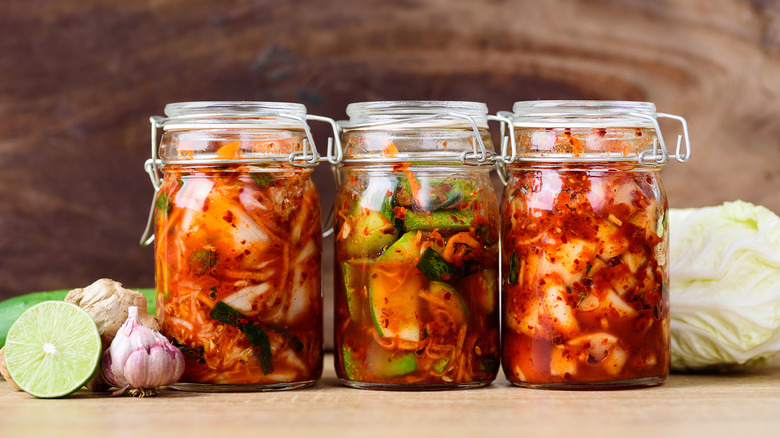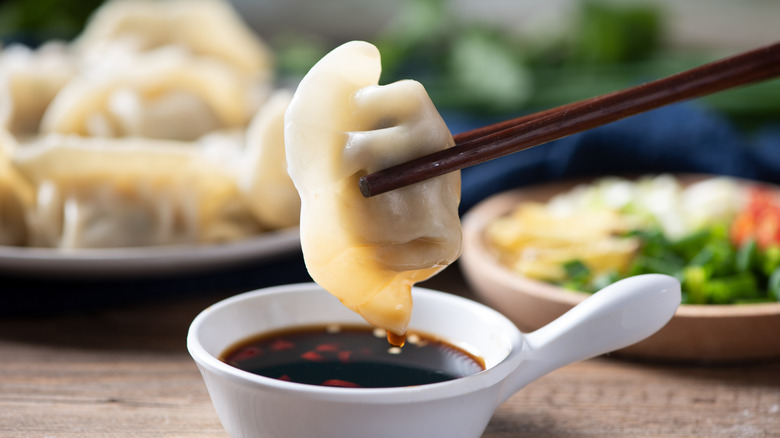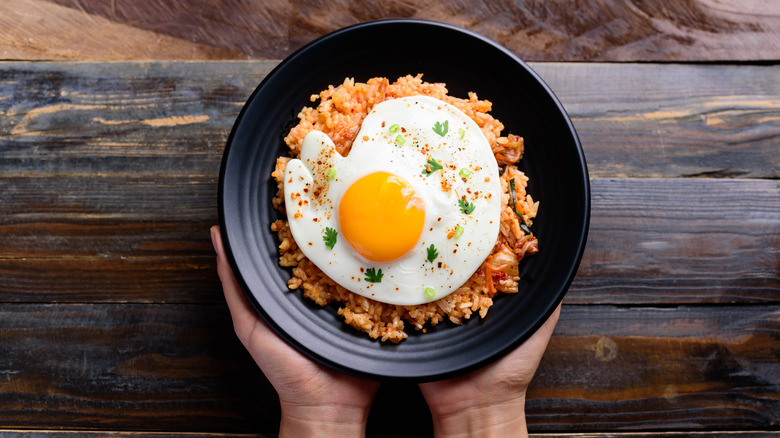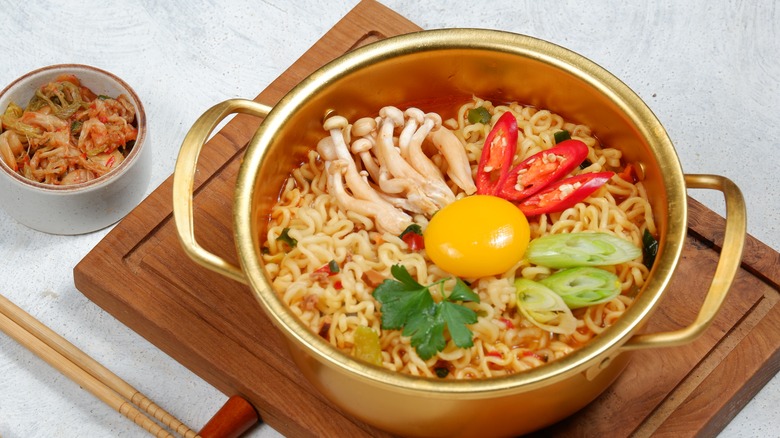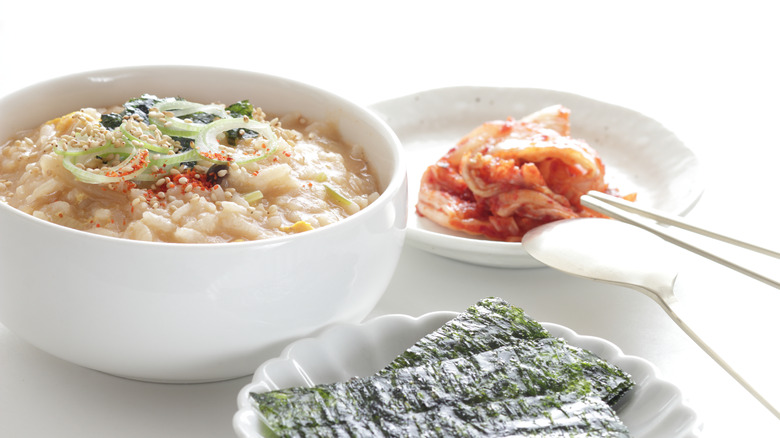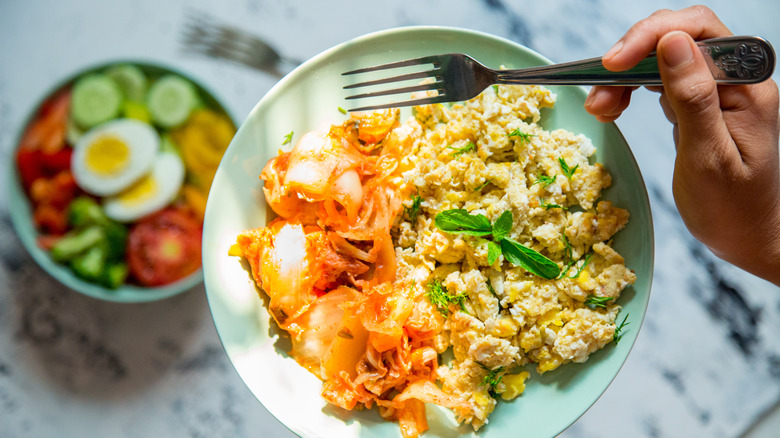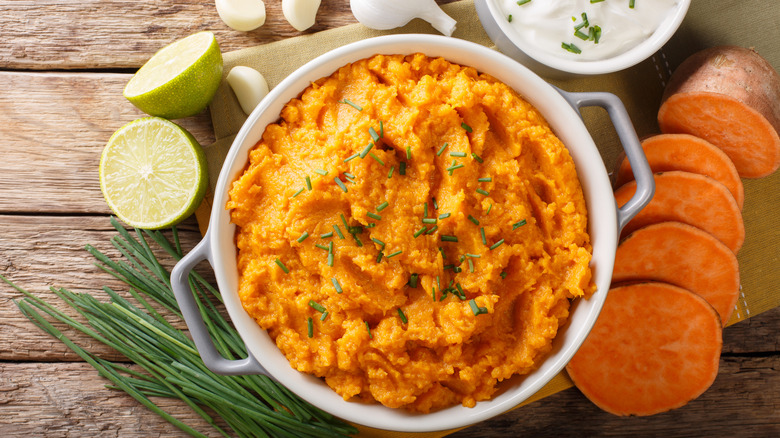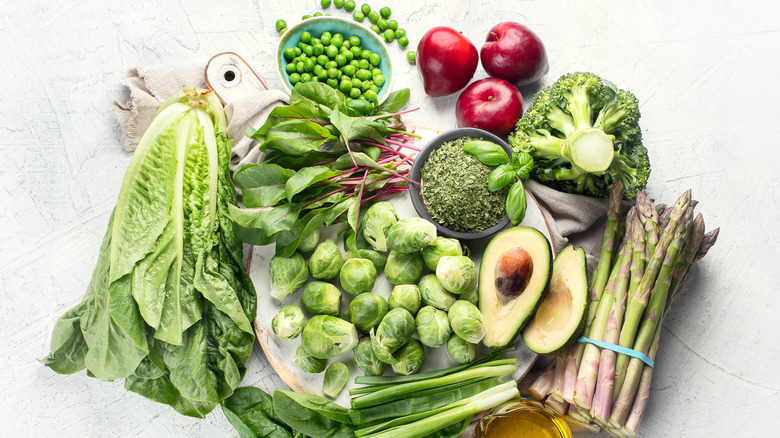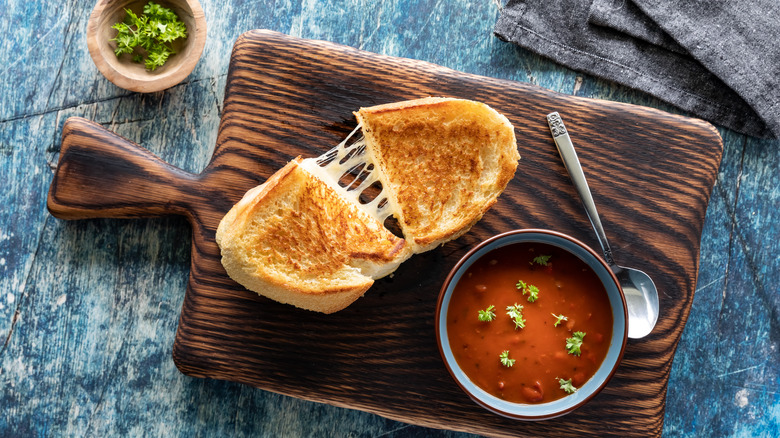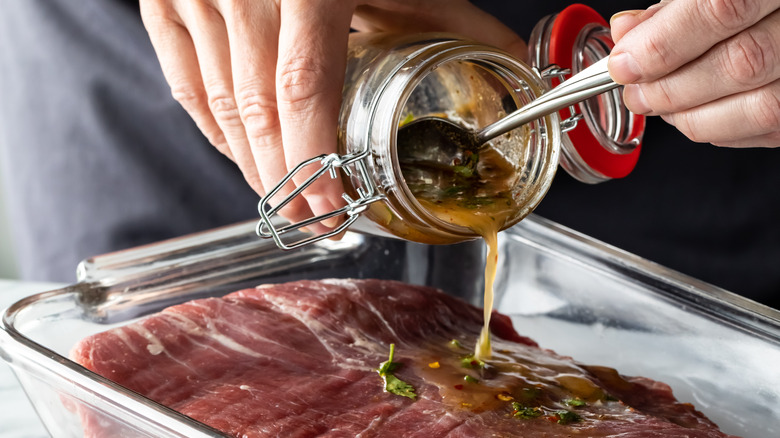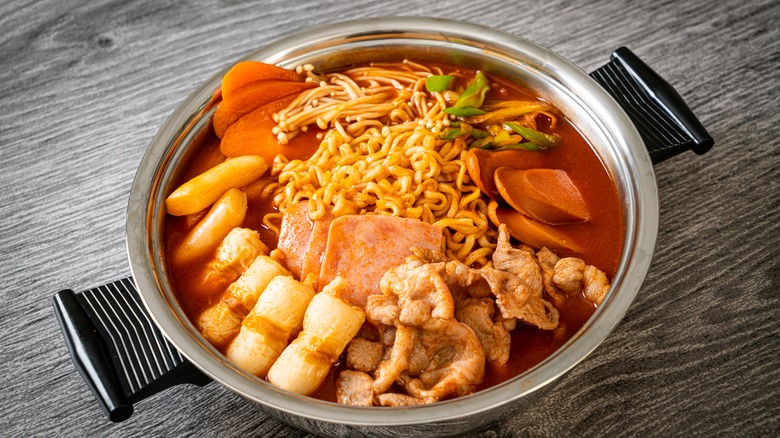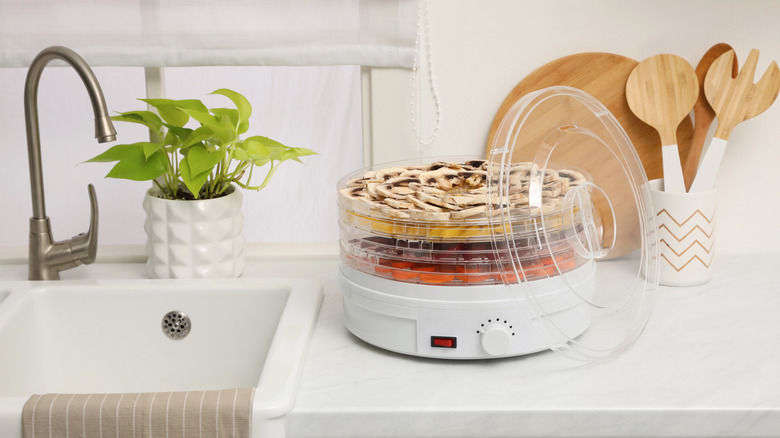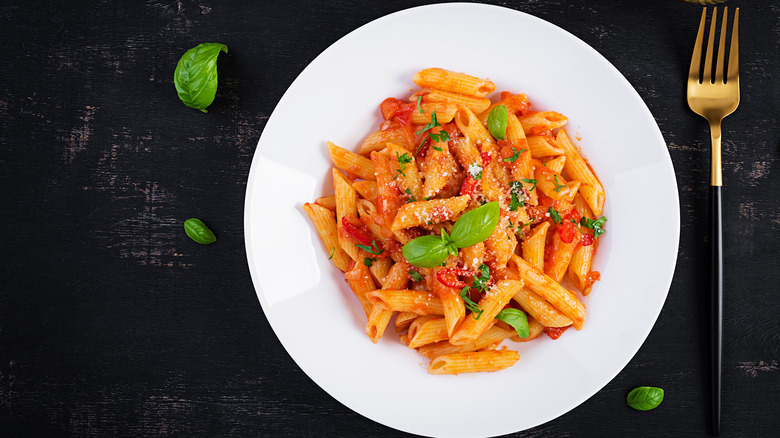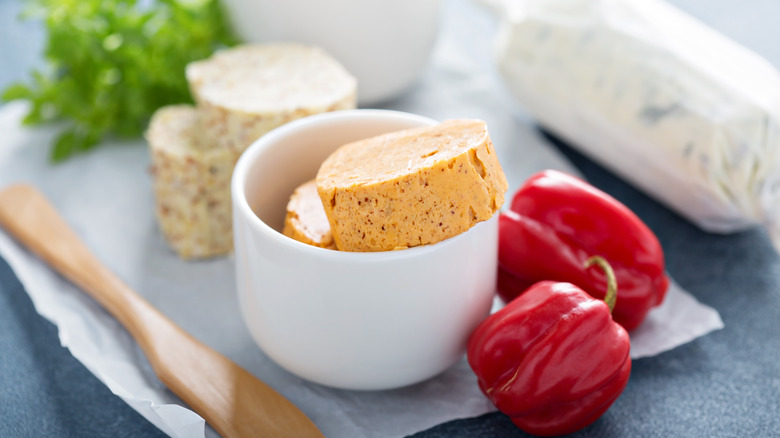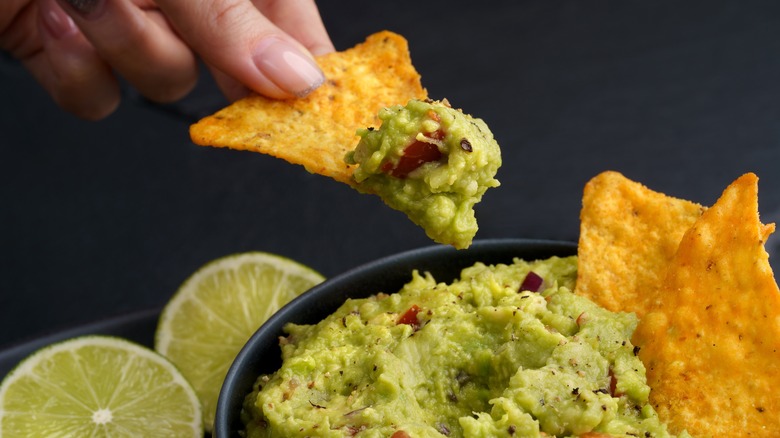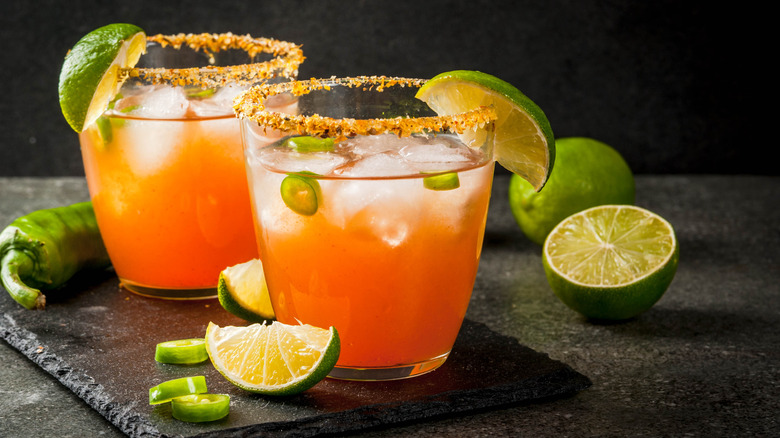20 Delicious Ways To Use Up Kimchi
Perhaps you bought some kimchi for a specific recipe or just to try it out, and now you have a half-eaten jar sitting in the back of the fridge waiting to be used. Maybe that jar has been in the fridge for quite a while and you're worried about how to finish it before the kimchi goes bad. The tangy fermented cabbage is a perfect accompaniment to meaty Korean barbecue, but how else can you use leftover kimchi? Creative chefs and home cooks have answered that question with a wide variety of innovative uses for kimchi inspired by traditional Korean recipes or infused into their favorite dishes from other cultures.
Both the vegetables and liquid can be repurposed, channeling the kimchi's unique qualities into dips, dressings, marinades, and more. Whether combining it with global cuisines to craft unexpected fusions, or lending the spicy, sour, and umami flavors of the funky condiment to a rich sauce or broth, kimchi might be the most versatile ingredient in your fridge.
Fill some dumplings
One of the most versatile foods on the planet with versions found in regional cuisines from Eastern Europe to China, dumplings are easy to make and the perfect vessel for bold and diverse fillings like kimchi. Transform leftover kimchi into a hearty and satisfying meal by mixing in some pork or tofu to create a homemade version of a classic Korean dish. The traditional Korean dumpling, kimchi mandu, can be enjoyed delicately steamed or fried and paired with sweet and savory dipping sauces. Lunar New Year celebrations in Korea feature a customary rice cake soup that often includes kimchi dumplings in a rich broth that is said to bring good luck and prosperity (via Culture Trip).
Get creative with your kimchi dumplings, straying from the traditional shapes and sizes to experiment with a tangy twist on fluffy bao or crisp egg rolls mixed and matched with sweet, savory, or spicy sauces.
Make fried rice
Kimchi fried rice, or kimchi-bokkeumbap, is a beloved comfort food for many Korean people and is a perfect dish to make when you need to clear out the fridge. Like most styles of fried rice, kimchi fried rice works best with rice that has dried out a bit after a couple of days in the fridge. Season the rice with the liquid from your kimchi jar and mix leftover pieces of the tangy cabbage and vegetables into the rice mixture. Top it off with some chopped green onion and a fried egg for an easy and satisfying meal. Korean-American music marketer Grace Lee shared her version of kimchi fried rice with the New York Times, including what she considers a quintessential addition of diced Spam.
Now the highest consumer of Spam outside of the United States, South Korea has had a decades-long love affair with the iconic canned meat which has become a staple ingredient in Korean cooking. The BBC chronicles the unique history of Spam as it made its way into the hearts and kitchens of South Koreans from its introduction by the U.S. Army during the Korean War through its rise in prominence as a popular premium gift and a symbol of both nostalgia and luxury. Although you could include other proteins in your kimchi fried rice, Spam is a classic accompaniment that ties this dish to its Korean roots.
Top your rice, noodle, and grain bowls
Drawing inspiration from kimchi fried rice, upgrade your rice, noodle, and grain bowls by topping them off with a helping of kimchi. The tangy topping makes an excellent addition to bibimbap, elevates instant ramen, and enhances other grains like quinoa, farro, or barley. One of the easiest ways to get creative with your leftover kimchi is mixing and matching it with your favorite proteins, vegetables, and finishing touches.
For a healthy option, try adding a hearty spoonful of kimchi to give some life to warm kale and farro salad. A more indulgent take might include incorporating the fun condiment along with some Kewpie mayonnaise into a cozy bowl of ramyeon or instant ramen noodles. With an easy-to-follow template like the guide described in the Washington Post, layering a base with protein, toppings, and sauces creates endless possibilities for using up leftover kimchi in a variety of unique and exciting combinations.
Spice up your savory breakfast
Bright and tangy kimchi wakes up breakfast staples like the popular Asian rice porridge and congee and offers texture and depth of flavor to those partaking in the savory oatmeal trend, highlighted by The New York Times. Congee is a satisfying breakfast that has sustained populations for centuries and continues to bring a sense of comfort to many people who grew up eating this savory breakfast. For Chinese-American chef Jenny Dorsey, congee is all about the toppings, including ingredients reflected in the flavor profile of kimchi such as fish cakes and pickled vegetables (via Huffpost).
For those enjoying kimchi for its health benefits, pairing this probiotic food with other nutritious staples such as oats is a great way to give your morning an easy and delicious nutrient boost. Go all in on your savory breakfast, topping your congee or oatmeal with vegetables like steamed spinach or bean sprouts and a dose of protein from a rich, runny egg.
Add it to eggs
From breakfast to appetizers, kimchi and eggs make an undeniably delicious pair. The bright sourness is a perfect foil to the rich, creaminess of scrambled eggs and the unctuousness of a runny yolk. Kimchi instantly elevates an average egg dish with its distinctive signature flavor profile. Bring color, texture, and depth of flavor to your breakfast by adding some kimchi as an easy upgrade to an egg scramble or egg toast. Enhance your omelets with a dollop of kimchi in your filling, mix a few spoonfuls into a batch of egg cups, or add some kimchi into your favorite breakfast sandwich or burrito.
Restaurants have also been boosting their egg dishes with kimchi, such as the kimchi-infused deviled egg appetizers found on menus in Los Angeles and across the country (via Los Angeles Magazine). Make this creamy and tangy appetizer at home by infusing the egg yolk and mayonnaise filling with the kimchi liquid or top your deviled eggs with finely chopped kimchi for a pop of flavor and crunch.
Mix it into mashed potatoes
Mashed potatoes are a blank canvas that can be painted with so much more than butter and cream. The Irish add color and texture to their colcannon mashed potatoes by incorporating green vegetables such as cabbage, leeks, and kale. In the United States, mashed potatoes are served dripping with rich, brown gravy, and mashed potato bars with dozens of toppings like bacon, cheese, and sour cream have become a popular trend. For Chef Debbie Lee, as she shared with NPR, kimchi mashed potatoes were born from a happy accident.
At Thanksgiving dinner, Lee's grandmother would bring a jar of kimchi to accompany the traditional American holiday fare. As Lee piled turkey, potatoes, and a scoop of kimchi onto the plate, the fermented juices would meld with the other food. Now, Chef Lee serves Thanksgiving with an Asian twist centered around the delightful fusion of flavors between the two cultures.
Season vegetable sides
Like Chef Debbie Lee's kimchi mashed potatoes, chefs such as David Chang have found ways to infuse flavors from their families and heritage with modern cuisine to create a unique and exciting experience. In an interview with CBS Mornings exploring their book, Cooking at Home, Chef Chang and his cookbook co-author, food journalist Priya Krishna, discuss their approach to home cooking by using recipes as guidelines, getting creative with seasoning, and utilizing the tools and ingredients already in the kitchen, including the microwave.
Glancing through the menus of Chang's restaurant empire, you will see the many ways the renowned chef uses kimchi to make everything from slow-cooked meats to roasted vegetables go from average to extraordinary. Eschewing the trend of just adding bacon to roasted Brussels sprouts that frequently appears in the appetizer section of restaurant menus, Chef Chang's roasted Brussels sprouts are enhanced with a kimchi puree, giving the dish a signature tangy funk. When searching for ways to use up kimchi, get creative pairing the bright, fishy notes of kimchi with your favorite vegetables from Brussels sprouts to green beans and more.
Pair it with cheese
The tangy acidity and crunch of kimchi are a perfect complement to rich, creamy comfort food, especially warm, oozy cheese. Try pairing leftover kimchi with a toasty grilled cheese or mix it into cheesy macaroni for a distinctly satisfying experience. With his iconic Los Angeles food truck, Kogi, Chef Roy Choi immortalized this delicious duo in his signature kimchi quesadilla, a combination of gooey jack and cheddar cheeses and caramelized kimchi.
Los Angeles' Koreatown has long been an important hub of culture and cuisine in the sprawling metropolis, from its connections to Hollywood history to its unique mix of Asian, Latino, and other cultures (via CNN). The menu at Kogi highlights the cultural diversity of LA as Chef Choi seamlessly blends ingredients and techniques from Korean and Mexican cuisines with a touch of California flair to create the vibrant fusion cooking that people can't get enough of.
Infuse American classics
Just as Chef Choi helped showcase the dynamic fusion of Korean and Mexican cooking in Los Angeles, home cooks and professional chefs like Judy Joo have been introducing the unique ways they have infused Korean ingredients, like kimchi, into classic American cuisine. Chef Joo tops her Krazy Korean Burgers with cucumber kimchi for a dose of bright acidity to cut through the fatty richness of the beef patty.
The Mother in Law's brand shares creative hot dog topping ideas featuring the signature ingredient inspired by flavor combinations from across the country, such as the Aloha Dog pairing tangy kimchi with smoky bacon and sweet pineapple relish, and the New All-American that uses kimchi to put a fresh twist on the classic chili cheese dog. Try infusing kimchi into your favorite traditional American dishes from barbecue to fried chicken to discover more exciting possibilities for this versatile ingredient.
Put it on pizza
A great pizza crust invites unlimited possibilities for expressing your culinary creativity. Part of what makes pizza so beloved is the ability to experience endless combinations of flavors, textures, and ingredients from traditional Italian pies to unique varieties with a delightfully unexpected assortment of toppings, including kimchi. While experimenting with flavors from her childhood as a Korean immigrant, Chef Ann Kim began infusing signature Korean flavors with pizza, creating a culinary phenomenon that helped launch her restaurant empire (via Modern Adventure).
According to Chef Kim, Korean food is about sharing, making it the perfect fusion with a social dish like pizza. CBS News highlighted the renowned Minnesota chef as she has been chosen to feature in Netflix's Chef's Table: Pizza, thanks to her thoughtful approach to pizza and her iconic creations. Check out the menus for Chef Kim's restaurants for more exciting inspiration for topping your pizzas with kimchi and other classically Korean ingredients.
Make salad dressing
Making salad dressing at home is a simple and easy way to dress up your greens. A basic salad dressing can be made by mixing a fat such as olive oil, and an acid such as lemon juice or vinegar, with some seasoning, and giving it a quick shake. With this base recipe, you can get creative with your combinations by swapping out or adding different ingredients.
Try exchanging the lemon juice or vinegar for the liquid in your kimchi jar. As explained in BBC Future, kimchi has a more delicate acidity than vinegar with a pH approximately equivalent to the tomato puree. Utilizing kimchi liquid for the acid component of your recipe offers a unique spicy-sour kick to your homemade salad dressing.
Flavor a braise or marinade
Acidic ingredients like kimchi have long played a critical role in the culinary world. Ingredients like vinegar, citrus, and tomatoes help balance the rich flavors of meats, sauces, and more while imparting brightness and additional layers of flavor to the dish (via Chicago Tribune). The acid plays an especially important role in braises and marinades for meat, poultry, or other proteins.
Crafting a perfect marinade requires achieving the right balance of fat, acid, sweetness, saltiness, spice, and aromatics. Including kimchi in your marinade imparts a unique depth to your final dish while helping to keep the proteins plump and full of flavor.
Intensify soups and stews
In the same way that kimchi imparts flavor, balance, and brightness to dressings and marinades, including kimchi in soups and stews can provide additional depth to your broth or base. Many traditional Korean soups and stews utilize kimchi, but the most iconic is a spicy South Korean soup known as budae-jjigae, or army stew (via NPR). The rich, red stew once again pairs kimchi with Spam as a reminder of its creation during the era of the Korean War.
After the war, Koreans would sometimes use the U.S. Army rations smuggled from military bases or donated by the soldiers to make this bold concoction of spices, noodles, Spam, sausage, beans, corn, and green vegetables. There are many varieties, and nicknames, for the dish, but no matter which name it goes by, this signature stew is a quintessential part of Korean food culture.
Dehydrate it
Although the short-lived kimchi chips at Trader Joe's didn't develop the cult following enjoyed by some of the store's signature products, the merits and applications of this dehydrated version of classic kimchi may have been underrated. From the start, the dried snack was polarizing with many appalled by the notion of dehydrated or freeze-dried versions of kimchi, finding it too fishy and overly salted (via Koreafornian Cooking). However, making dehydrated kimchi at home allows more control over the amount of fish or anchovy paste, salt, and seasonings that go into it, so it is easier to rectify the problems experienced by the failed Trader Joe's iteration.
All you need is leftover kimchi, an oven on low heat or a dehydrator, and several hours to let the liquid evaporate until the pieces are crisp. Once they are crunchy, eat them like chips or blitz some in a blender to use as a bold, crumbly topping for casseroles, pasta dishes, soups, salads, and more.
Turn it into pasta sauce
Although kimchi is often eaten cold, the tangy ingredient can also be enjoyed cooked. Caramelizing the inherent sugars in the kimchi with some heat and browning the fermented cabbage bits gives each bite a unique taste. The Science of Cooking explains that browning is a result of the Maillard reaction that causes color and flavor changes in food. Applying this technique to kimchi amplifies the umami-producing compounds and gives kimchi pasta sauce an intensity that sets it apart from the average tomato-based sauce.
As the kimchi breaks down in the pan to create your sauce, add aromatics like garlic and herbs, a drizzle of olive oil, and some seasoning to craft a simple sauce that coats the pasta with a bold punch of flavor.
Whip up some kimchi butter
Everything is better with butter, including kimchi. Compound butters are surprisingly easy to make and can be used to amplify the flavor of a wide range of dishes from steak and roasted vegetables to pastries and desserts. Simply mix finely chopped kimchi and its liquid into softened butter, shape, and put it in the refrigerator to solidify, creating a flavorful butter to use for finishing dishes and even baking.
In his review after a visit to Momofuku, renowned cookbook author and food writer, David Lebovitz, highlights David Chang's simple yet impactful kimchi butter. Chef Chang uses the bright orange butter in the kimchi and blue cheese croissants to create a wonderfully unique combination served in the bakery, but the possibilities for this creative, savory take on compound butter seem deliciously endless.
Eat it with ice cream
Kimchi and ice cream may sound like a strange pregnancy craving, but the tanginess of the kimchi can be harnessed to complement sweet, creamy dairy surprisingly well. Although it certainly may not appeal to everyone, kimchi ice cream, like the version created by David Choi, is a combination that sounds so absurd, that you absolutely have to try it. As reported by the Riverfront Times, Choi's version served at Seoul Q accompanied by sesame seed crackers and fresh mint, then drizzled with spicy honey was unexpectedly pleasing on the palate.
The sweetness, followed by the gentle heat of the honey, blends with the notes of sour funk to create an intriguing and complex dessert. Don't be afraid to experiment with kimchi in the realm of sweet treats. You might just come up with the next dessert sensation.
Make a dip
Versatile kimchi pairs well with just about everything, making it a perfect inclusion for a wide range of dips and spreads. To make a creamy dip with a bit of a funky tang, try mixing kimchi with a yogurt base for a delicious double dose of probiotics. The Fermenter's Club recommends including kimchi the next time you stir up a batch of guacamole for a Korean-Mexican fusion dip that Roy Choi would be proud of.
From kimchi buffalo chicken dip to creamy kimchi hummus, making creative dips and spreads is a great way to add incredible flavor as you use up that jar of kimchi.
Bring it to brunch
Give your classic brunch a tangy Asian twist with the addition of bright, punchy kimchi. Because kimchi works so well with both sweet and savory flavors, it can be seamlessly integrated into a variety of signature brunch dishes from eggs or pastries to the iconic avocado toast.
Restaurants like the California-based Bone Kettle have been incorporating Asian ingredients into their brunch menu to create a smorgasbord of offerings that play with the boundaries between savory, sweet, and spicy. Drawing inspiration from these innovative menus, you might experiment with a spicy kimchi syrup for your pancakes and waffles or a rich, kimchi hollandaise to brighten up the traditional eggs Benedict.
Stir up a cocktail
Kimchi is so versatile that it can even be used to enhance your cocktails. From Bloody Marys at brunch to a spicy kimchi margarita at dinner, kimchi elevates classic boozy beverages with its unique spicy-sour kick.
Another example of the uncannily perfect pairing of Korean and Mexican cuisines is a kimchi michelada. The michelada is a staple drink during Mexican summers, made with a refreshing combination of beer, hot sauce, seasoning, and lime served in a chilled, salt-rimmed glass. Inspired by the Mexico versus South Korea match at the 2018 FIFA World Cup, the organization offered its take on the classic Mexican drink finished with signature ingredients from the dueling countries (via YouTube). Savory cocktails like these are another delicious way to use up kimchi.
